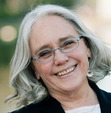Edith Maxwell's Blog, page 105
January 28, 2021
Trouble in a Teacup #giveaway
Edith/Maddie here, not sure how it got to be the end of the month already! I’m so happy to welcome my friend Alyssa Maxwell back to the blog. Her new book comes out [??]. Here’s the blurb:
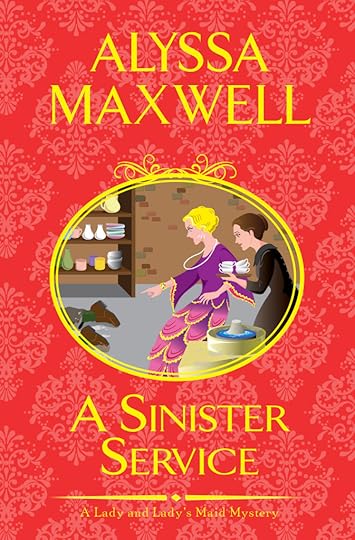
Lady Phoebe Renshaw and her siblings travel to Staffordshire to commission a china service bearing the Wroxly coat of arms from the venerated Crown Lily Potteries, a favorite of Queen Mary. The two leading designers at the illustrious china manufacturer offer competing patterns. But when one of them is found dead—his body crushed in a grinding pan and his design pattern book missing—his rival is immediately suspected. The police are also suspicious of the dead designer’s resentful young son, a schoolmate of Phoebe’s fifteen-year-old brother Fox. When Fox gets involved to help his friend, Phoebe begins to investigate the rival artist.
At the same time, Eva is enlisted to go undercover at the works so she can gain the confidence of the female employees, who are only allowed to paint, not design, which may have led to a grudge against the victim. Pursuing a killer who has no compunction about using a kiln as a coffin, Phoebe and Eva take their lives into their hands to discover the shattering truth . . .
Trouble in a Teacup
What could possibly be troublesome about teacups and fine bone china? China is lovely. It’s elegant. It raises drinking tea to an artform.
It can also cause a good bit of havoc.
In A Sinister Service, Renshaw siblings Phoebe, Julia, Amelia and Fox travel to Staffordshire to commission a unique tea service for the grandparents’ anniversary. What begins as a happy endeavor to procure a special gift soon becomes an ordeal rife with conflict. To begin with, each sibling has a definite view of what their grandparents would like—and none of them are in agreement with the others. Then, at the fictional Crown Lily Potteries, egos and ambitions have not only set the two top designers at odds, but other department heads as well. Rivalries and resentments burn as hot as the kilns at every turn. When one of the designers turns up dead in a clay mixing vat, his teenaged son, a friend of Fox’s from Eton, is accused. But from their tour of the Crown Lily Pottery Works, Phoebe and her lady’s maid, Eva, know the boy wasn’t alone in possibly wanting his father out of the way. They resolve to discover the truth.
Well, leave it to mystery writers to envision the worst in even the most innocuous of circumstances.
So, why teacups? My own love affair with fine bone china developed only in recent years. Unfortunately, I didn’t inherit lovely china from a grandmother or anyone like that. Or did I?
One day, I received a gift of four beautiful Shelley China cups and saucers. The Shelley Pottery Works, I soon learned, was one of Staffordshire’s premier china producers. These particular teacups came to me from the daughter of an elderly reader who had recently passed away; it was a thank you for the joy my Newport series had brought her mother in her final days. She had lived in Newport during the 40s and 50s, and the books brought her back to what had been some of her happiest years. Turns out, those cups had also been a gift to her—from my husband’s own great aunt, who had been her friend and landlady. Talk about a small world. Talk about karma. Talk about coming full circle.
I quickly became an avid collector of Shelley china—I, who had never really collected anything before. But I knew from the moment I opened the package that I held something extraordinary in my hands. I educated myself about Shelley to discover it was indeed one of the—if not THE—most exquisite of all English fine bone china. It’s all about their ratio of raw clay to stone to beef bone ash, which allows Shelley china to be translucent thin, yet incredibly strong and enduring.
And then, of course, my dastardly mind began to conjure. And although the original four teacups in my collection came as a result of my Newport series, it only made sense to set a story about English china in England, during the years when the industry was about to experience a resurgence following WWI. It may have been Emma Cross who is responsible for this non-collector becoming a collector, but it’s Phoebe Renshaw and Eva Huntford who spring into action and follow the clues to a murderer at the fictional Crown Lily Pottery Works in Staffordshire, England.
Following are some of the shapes and patterns in my collection that helped inspire A Sinister Service. They span from the 1890s to the early 1960s.
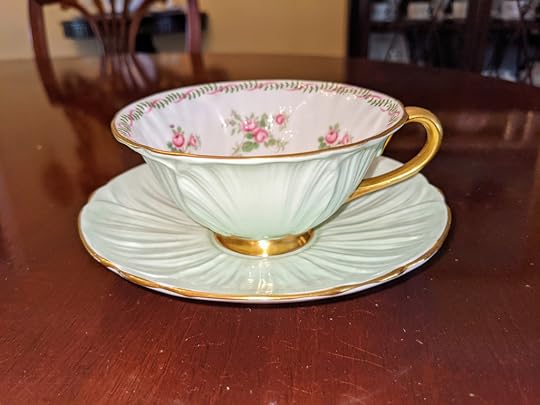
One of the original four: Footed Oleander shape with the Bridal Rose Pattern inside. Circa 1940s.
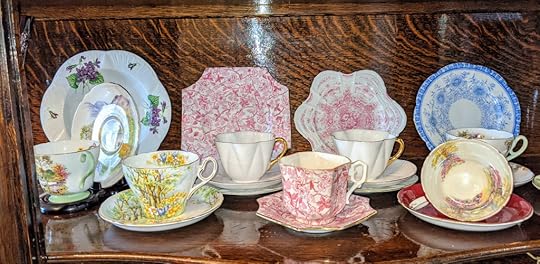
The pink one, front and center, is a “pre-Shelley” Wileman & Co. cup from the 1890s.

Three examples of Regent shape, from the early 1930s.
Readers: Are you a collector? If yes or no, and no matter what it is, share below for a chance to win a signed hardcover copy of A Sinister Service! (One winner will be chosen, must reside in the U.S. due to shipping costs.)
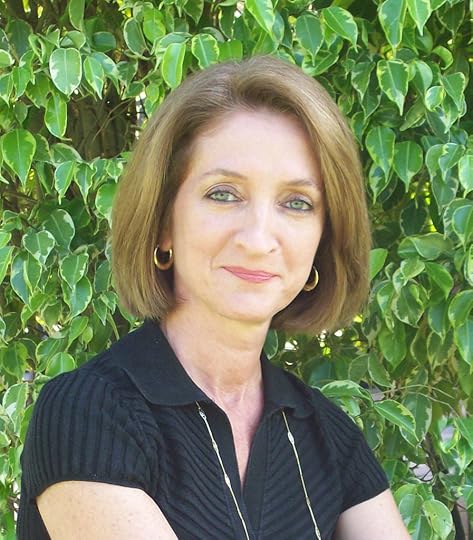
Alyssa Maxwell knew from an early age that she wanted to be a writer. Growing up in New England and traveling to Great Britain fueled a passion for history, while a love of puzzles drew her to the mystery genre. She is the author of The Gilded Newport Mysteries and A Lady and Lady’s Maid Mysteries. She and her husband reside in Florida, where she is a member of the Mystery Writers of America-Florida Chapter, Sisters in Crime-Treasure Coast Chapter, and the Florida Romance Writers. You can visit her at www.alyssamaxwell.com, where you can find all her social media links.
January 27, 2021
Wicked Wednesday: First International Travel
For our last Wicked Wednesday of the month, in a year when nobody is safely leaving the country (or even our own homes), let’s reminisce about the first time we traveled internationally. Where did you go, and under what auspices? What was the best thing you ate? Who did you meet? Have you used any of that experience in a novel or short story? Edith/Maddie will give away a copy of Murder on Cape Cod, because protagonist Mac Almeida was a world traveler before she settled back in her Cape Cod home town.

Julie: In between my junior and senior year of high school I was an AFS student in Tournai, Belgium. I had taken French in school, so I thought I was prepared. LOL. I was there for ten weeks. What a wonderful, wonderful experience. My host family, the Provis family, were lovely. I did have to go camping and got sick (not so great), but other than that, it was life changing. I promised my grandmother (who wrote to me every week) that I would eat everything that I was offered, which I did, though the kidneys were a moment. I made apple pie and chocolate chip cookies for my going away party, both of which were a big hit. I’m so glad that I took that opportunity for an adventure.
Edith/Maddie: Julie, somehow I never knew you were an AFS student! I was too, in southern Brazil for the entire year of 1970. (I’d been to Mexico with my class in sixth grade for a week, but we drove down there in buses from my LA suburb. The Brazil experience was much bigger.) I was barely seventeen when I left, and my exchange student year changed my life. First time on a plane. First time in a hotel. First time learning a language by immersion. First time realizing how ego-centric the US is – in Brazil, the newspaper carries world news on the front page. First beer, first hard liquor, first cigarette. And hearing about a tenuous democracy from a high school friend who was a journalist and spoke of the kinds of news he wasn’t allowed to write about. I ended up with a lust for world travel, a much broader perspective on life, and fluency in Portuguese that’s still nearly native.
Barb: My first real international trip was in the fall of 1970 when I was a Rotary Exchange student in Bogota, Colombia. The nine months I spent there had a profound effect on me. First and foremost, living abroad confirmed my identity as a American and my belief in our democracy.
When I left the US that fall, things had been in constant turmoil for years. From the assassinations of Martin Luther King and Robert F. Kennedy to the Chicago Democratic convention to the ever-increasing protests against the Vietnam War. In May, National Guard soldiers had killed four student demonstrators at Kent State. It had never occurred to me that my government would kill people just like me. (Insert your own observations about my teenage naivety and privilege here.) The situation in my country felt very shaky to me.
But then in April, 1971, in Colombia there was a student strike and other indications of insurrection. The government declared “estato de sitio,” a state of siege. There were tanks and soldiers in the streets, but more profoundly, rights Americans think of as fundamental were suspended: Freedom of speech, meaning what it actually means, that if you made disparaging remarks about the government, even in private, you could be arrested by that government. And freedom of assembly, meaning not more than four people could gather in one place, which practically meant that my large Colombian host family had to break up into groups to wander through the farmers market and kids waiting for the school bus, when there was school, couldn’t hang out together. These suspensions were accepted by most citizens. And all this happened during one of the most stable periods of governance Colombia has ever had. The difference between a twenty-year-old pseudo-democracy and what was then our nearly two hundred year-old democracy felt vast.
The whole experience taught me how strong and ingrained US democracy was. How, though we disagreed on so much, we depended on laws, traditions, and shared beliefs I regarded as unshakeable to keep it going. Which is why, when, three years later the President resigned, I never doubted for a moment the Vice President would take over and run the country until the next election. And there would be a next election. That belief in the unshakeability of our democracy has carried me from that day to this, through the Clinton impeachment, Bush v. Gore, 9/11, and crises that would cause weaker democracies to topple. Needless to say I have thought of this often in the last days and months. I have held on to the optimism about our democracy that I learned in Colombia, but I have never questioned it more.
Jessie: Barb, that is such an engaging story! I knew you had been in Colombia but I had no idea that the trip had included so much unrest! I am always surprised at how American I feel whenever I travel abroad too!
Since we are talking about first international travel, I would admit mine was not all that glamorous. I was about a year old and lived with my family in Detroit. All the rest of the relations were in Maine and my parents wanted to go back for a visit so we took the route up into Canada and then down back into Maine. I was being potty-trained at the time and the gas shortage was on. Most of the filling stations were closed and so there were no available bathrooms. From what I understand from my mother, it was a difficult trip. I had decided that diapers were not for me any longer and refused absolutely to use the odd outhouse that was presented. I am still not a fan of primative plumbing!
Liz: Jessie, LOL! I dislike outhouses too…So aside from a trip to Canada on a snowmobile and the odd weekend in Montreal, my first international trip was London. I loved it so much – I immediately felt at home. On my first trip there, I visited the Tate Modern, Shakespeare’s Globe Theater, and I did a Jack the Ripper tour – which was so cool. I also ate Indian food on Brick Lane, visited some outdoor markets, and went to the famous store Fortnum and Mason, where I got rose and lavender ice cream–so yummy!
Sherry: Liz, I loved London too when we went. My first trip was to Tijuana, Mexico in third grade when we were visiting friends in California. I bought a marionette that I had for many years. In fifth grade another cross country trip included the Canadian side of Niagara Falls. My dad and I went up in the Skylon tower and actress June Lockhart was there.
Readers: Share your first international trip! If you haven’t had one, what country do you long to visit?
January 26, 2021
Guided by the Moon
By Liz, wishing I was somewhere warm right now…
One of my favorite things about my Full Moon Mysteries is getting to incorporate moon stuff and crystals into the mysteries. Since I’ve talked a lot about crystals here, I thought I’d spend some time on the moon.
I’ve always been fascinated by the moon phases and the lunar cycle and the power it holds. I never really dug in to what it all meant until the last couple of years as I was doing my research for the books. As part of that research, I started going to moon circles – after I was lucky enough to meet some people at my yoga studio who held them. They were usually done around either the new or the full moon, and they were incredible experiences. We did a lot of manifesting, a lot of intention sharing, and one night we even called in a storm.
I also learned that each of the moon phases mean something energetically – it’s not just about the new and full moons.
 My new moon phase tapestry
My new moon phase tapestryMy Moonology daily planner has exercises you can do to prepare for the new and full moons, which is really helpful to get my intentions and wishes down on paper, and also for noting the things I want to let go. It also helped me get the eight moon phases straight:
New Moon – new beginnings, planning for our futureCrescent Moon – great time to manifest our intentionsFirst Quarter Moon – halfway between the new and full moon, and a time when we need to commit to our new moon goals. Also a time when crises could ariseGibbous Moon – brings up lots of emotionsFull Moon – the time to surrender our wishesDisseminating Moon – all about breathing and letting goThird Quarter Moon – More learning experiences, reflecting and letting goBalsamic Moon – Healing and soothing timeOne tool I found super helpful was moonsightplanner.com – a digital calendar that gives you the lunar calendar daily and summarizes what each part of the cycle means from a productivity perspective, as well as the astro transits. It’s so cool to realized that how your mood corresponds with the cycle – for example, if you’re feeling unproductive it could be a void moon, a day in which more contemplation than action is suggested.
The next full moon is Thursday, the 28th. It’s a full moon in Leo, and it’s supposed to be pretty intense. It’s a great time to make a list of that which you want to let go of (and we probably all have a lot of those things left over from 2020). I’m going to be doing that before Thursday to help me move into the rest of the new year with a clean slate.
Readers, what do you want to let go of this full moon? Tell us below!
January 25, 2021
Four Guests: Lies and Truths
Edith/Maddie here, shivering from the cold, but hey, it’s winter. I’m so happy to welcome a talented group of authors, all with February releases, all published by Level Best Books.

Liz Milliron: Thanks so much for hosting us here at Wicked Authors!
When our group got together and realized we all had February releases, we started thinking about what our books had in common. We write historical, contemporary, traditional mystery, thriller, suspense…the genres cover the spectrum. But the one thing we had in common was the thing that all crime fiction has in common – truth and lies.
Not only do our characters lie – they have to, because otherwise there isn’t much of a story – we lie a little bit, too. All of our books come from a bit of truth. It’s a beautiful thing about being an author. The ability to take a real event and twist it to make a good story. Today the four of us dish on our lies – and our truths.
Mally Becker: My mystery, The Turncoat’s Widow, tells the fictional story of General Washington’s most reluctant spy, a young widow who races time and traitors to uncover a plot that threatens the new nation.
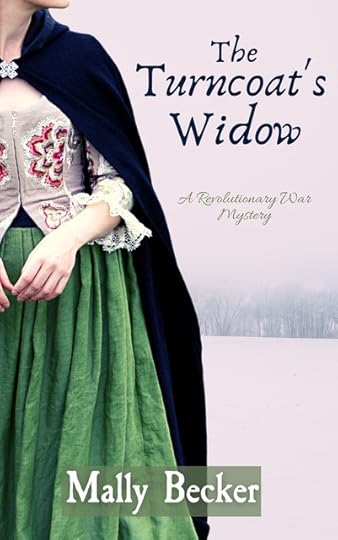
The book was born, so to speak, at the Morristown National Historical Park, where Washington and his men spent two miserable winters. I was volunteering there when I found a dry-as-dust old document, a Revolutionary War-era indictment for the crime of traveling to New York City “without permission or passport.”
A crime to head into Manhattan? I’ve lived in or near New York City for most of my life, and that document stopped me in my tracks. I brought it to one of the Park historians for an explanation.
The population wasn’t entirely sold on independence, he told me. Less than 50% of people south of New England supported independence, historians believe. And there was so much spying and smuggling between New York City and nearby New Jersey, that the government criminalized travel into the City without permission. I’d forgotten that England controlled NYC for most of the War.
A divided nation. Spying and smuggling. All of a sudden, the 18th century seemed very present. My plot started to take shape.
Facts alone don’t make a story, of course. I needed a heroine, and I found one I hope you like as much as I do. Becca Parcell is too busy struggling to survive in Morristown to give a fig – at least at first – who wins the War for Independence. But when the town wrongly accuses her of supporting England and causing her patriotic husband’s death, General Washington offers her a deal she can’t refuse.
The Turncoat’s Widow can be preordered now and will be published on February 16.

Liz Milliron: The main character in my Homefront Mysteries, Betty Ahern, is inspired by my grandmother, who did work at Bell Airplane during WWII. Grandma was not Irish and I think she was a little older…and she definitely didn’t solve mysteries. For this book, I learned that the Polish Government in Exile (the Polish leaders who considered themselves the true government of Poland, as opposed to the puppets installed by the Nazis), visited Buffalo in December 1942. I didn’t learn much about why, but most likely it was to raise awareness and money. Buffalo did, and still does, have a vibrant Polish culture. That’s the truth.
Of course, that’s interesting…but boring, right?
What’s the lie? Well, there probably wasn’t a junior undersecretary named Josef Pyrut. He wasn’t possibly related to the old woman in the story, Pelagia Brewka. And he didn’t die. There are a few other lies, but you have to read the book to find out what they are.
Kerry Peresta: When people ask what The Deadening is about, I give them the short version— that my book is about the deadening and resurrection of a woman’s soul. The first impression is usually “Ooooohh,” or something similar. This was also my reaction when I met the catalyst for this story.
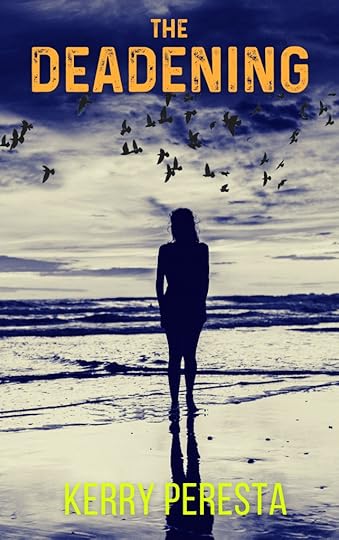
At a signing event for my first book, The Hunting, ten authors sat at rectangular folding tables arranged in a “U” at a local library. The event had been highly publicized, and potential book buyers bustled in and out of the room. Energy was high. Sales were so-so. But at one author table, energy bounced off the ceiling, drawing customers like flies to honey. I couldn’t stand it. I had to find out what was so appealing about this author.
I scooted across the room and presented myself to a curly-haired woman in her thirties who, in between selling books, wrote longhand in a notebook. With a pencil, no less. Her smile was blinding. I pointed to the notebook just to have something to say. “You still use longhand, huh?”
The smile increased. “Can’t help it.” She fluttered the hand that held the pencil and laughed. “I write all the time, in spite of whatever I’m doing.”
I glanced at the flock around the table studying her books while other authors struggled to get one person to read back cover copy. “I don’t mean to be…um, too personal, but you’re the most magnetic person in the room. What’s your secret?”
With a twinkle in her dark, almost black, eyes, she focused on my face. “I was in a car wreck that almost killed me. Took six months for me to wake up from a coma.”
I wiggled my hands in protest. “You don’t have to talk about this if—”
She laughed. “No, no, I love to talk about it! Because, when I woke up…” she made a raking motion up and down her body with the pencil hand, “…I was like this! Totally different! I can’t quit talking!” She shrugged.
“You mean…your personality changed?”
“Totally. Cool, right? I was never this way before.” She flashed that smile again. A customer nudged his way in front of me, and I took that as my cue to leave.
The Deadening was born right then and there.
C.L. Tolbert: The Redemption, is set in New Orleans in 1994, which was a tough year for the city. The murder rate was greater per capita than any other U.S. city, and police corruption had reached an all-time high. The story begins with a double murder. A young man, who is only sixteen years of age, is accused of the crime.

The inspiration for the book was a similar crime ˗ the murder of a 38 year old man by a fifteen year old in New Orleans. In the actual case, I filed a motion preventing the juvenile’s transfer to the adult prison system. I won, presumably keeping him out of harm’s way since the death penalty was a possibility for juveniles tried as adults at that time. The young man was subsequently tried before a juvenile judge, without a jury. Even though we were able to prove there were several shooters by the angle of the entry wounds, and that none of the shooters could have been the defendant, the fifteen year old was sentenced to serve time in the juvenile system until age twenty one. It was clear that after his release, he’d be treated as a hero within his community for “taking the rap” for the murder, further entrenching him into the gang environment.
The judge believed the young man should serve time rather than return to his criminal family. Convinced that the young man’s future was set, the judge was trying to prolong his “inevitable” foray into crime by having him receive training and education through juvenile services. There would be no redemption for this young man.
In the book, the facts are changed. The young man/protagonist charged with the double murders isn’t in juvenile court, but instead, quickly finds himself transferred to the adult system, indicted, slated to be tried as an adult, and thus subject, (since it was prior to the Supreme Court’s decision in 2005,) to the death penalty. But with this set of facts, some soul searching on the part of the young man, and a good deal of confrontation by his attorney, Emma Thornton, redemption is realized.
Readers: Has an episode in real-life ever inspired fiction for you (story, poem, song)?

Mally Becker became fascinated with the American Revolution when she peeked into the past as a volunteer at the Morristown National Historical Park, where George Washington and the Continental army spent two winters. A former attorney, advocate for foster children, and freelance writer, Becker and her husband live in Warren, NJ, where they raised their son. The Turncoat’s Widow, featuring Becca Parcell, is her first novel.

Liz Milliron is the author of The Laurel Highlands Mysteries series, set in the scenic Laurel Highlands of Southwestern Pennsylvania, and The Homefront Mysteries, set in Buffalo, NY during the early years of World War II. She is a member of Sisters in Crime, Pennwriters, and International Thriller Writers. A recent empty-nester, Liz lives outside Pittsburgh with her husband and a retired-racer greyhound. http://lizmilliron.com
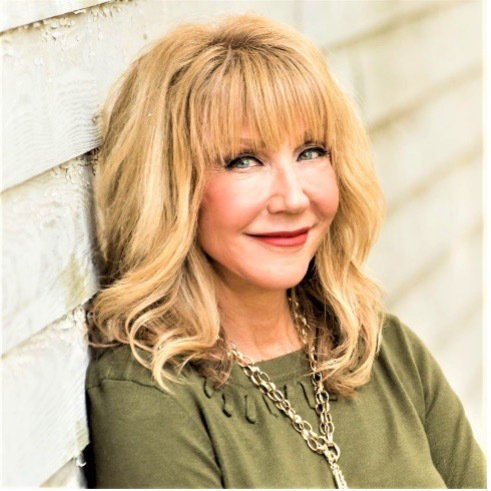
Kerry Peresta’s publishing credits include a popular newspaper and e-zine humor column, “The Lighter Side,” (2009—2011); The Hunting, women’s fiction/suspense, Pen-L Publishing, 2013; and The Deadening, Book One in the Olivia Callahan Suspense Series. Recently, she worked as editor and contributor for Island Communications, a local publishing house. Her magazine articles have been published in Local Life Magazine, The Bluffton Breeze, Lady Lowcountry, and Island Events Magazine. Before starting to write full time, she spent twenty-five years in advertising as an account manager, creative director, and copywriter. She is past chapter president of the Maryland Writers’ Association and a current member and presenter of Hilton Head Island Writers’ Network, and the Sisters in Crime organization. Kerry is the mother of four adult children. She and her husband moved to Hilton Head Island, SC in 2015.
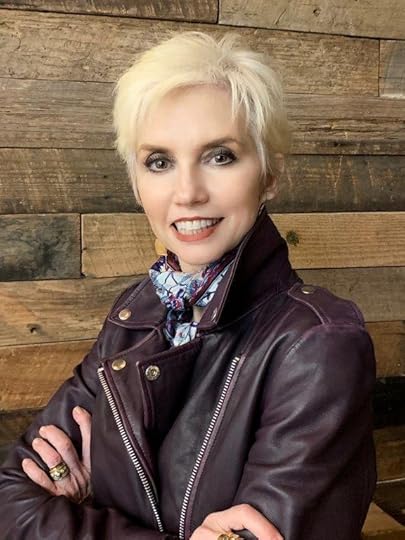
In 2010 Cynthia Tolbert won the Georgia Bar Journal’s fiction contest for the short story version of Out From Silence. Cynthia developed that story into the first full-length novel of the Thornton Mystery Series, which was published by Level Best Books in December of 2019. Her second book in this same series, entitled The Redemption, which is set in New Orleans, will be released in February of 2021.
January 22, 2021
Cover Reveal of A Changing Light #giveaway
Edith writing with hope from north of Boston.
I’m excited to present the hot-off-the-press cover for A Changing Light, my seventh Quaker Midwife Mystery!
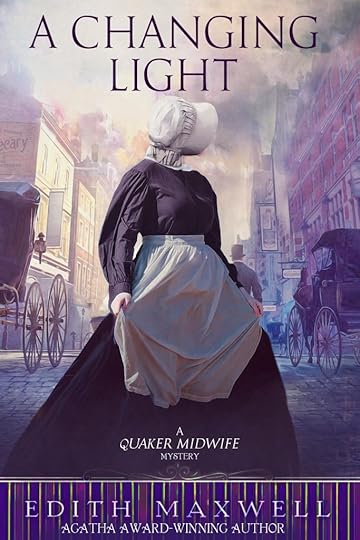
Isn’t it stunning? Here’s the blurb:
In a new mystery from Agatha Award-winning author Edith Maxwell, midwife Rose Carroll confronts a killer on the cusp of a new age . . .
As the nineteenth century nears an end, midwife Rose Carroll can see signs of progress and change everywhere in her Amesbury community. Adding to the excitement is the annual Spring Opening, when the town’s world-famous carriage manufacturers throw open their doors to visitors from all over the globe. This year’s festivities are tainted, however, when a representative from a prominent Canadian carriage company is murdered.
Driven by her strong sense of justice, Rose is determined to track down the killer. She has only just begun her investigation when she learns that the plans for a radical new horseless carriage have gone missing. Faced with the question of whether the two crimes are connected—and a list of suspects that includes some of Amesbury’s own residents and any number of foreign visitors—Rose has to delve into a case with implications for the future, even if the motive for murder is one of mankind’s oldest . . .
The book releases April 13 and it’s is up for pre-order now. (A temporary glitch doesn’t show it connected to the previous six books in the series, but they’re working on that.)
I very much enjoyed writing this book and bringing the real Amesbury Spring Opening into the story. Tuberculosis, which was running rampant at the time, plays a role, as well. Rose has lots of changes going on in her personal life to match those in the 1890 world around her!
Readers: Which historical events spark your interest? Do you have a favorite era to read about? I’ll send one commenter an ebook version of Taken Too Soon, the previous book in the series.
January 21, 2021
Genre Hopping with Joanna Schaffhausen
Edith/Maddie here, pleased to welcome our first guest for a new feature on the blog. Each month on the third Thursday we will invite an author who writes in a genre none of the Wickeds is currently published in to talk about their work and their writing, plus other fun questions.
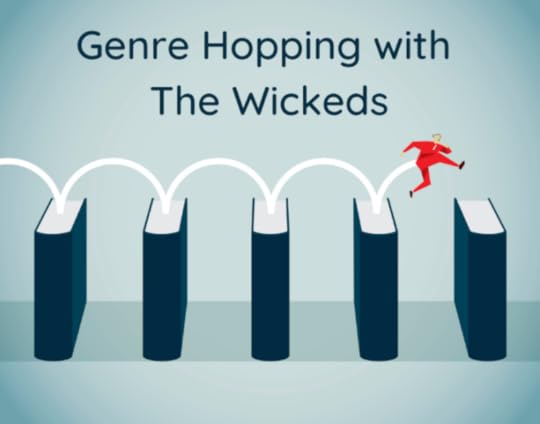
I love Joanna Schaffhausen‘s work and am thrilled she agreed to be our first guest in the feature. Joanna, who lives in the Boston area, writes hugely successful books categorized as serial killer thrillers, police procedurals, and crime thrillers. Her Ellery Hathaway series has been described as having heart-pounding suspense, and her latest one, Every Waking Hour, comes out next week. She’s giving away a signed copy to a commenter, too (US only)! So let’s see what she has to say.
E: What drew you to the genre you write?
J: I have been writing mysteries since I was watching Scooby Doo and learned how to hold a pencil. I liked the puzzle aspect and still do. In grade school, I used to write whodunnits for class assignments and put the solution upside down at the end. As an adult, I appreciate the way crime stories can illuminate different aspects of human society. What is often revealed isn’t pretty, but I still hope that the long arc is bending toward justice.
E: What sets your book apart from what is out there?
J: I think the characters are the memorable part of any book. We authors are told there are only seven basic plots, right? The people who live the adventures are the fun, differentiating aspect. The two characters who anchor my main series, Ellery Hathaway and Reed Markham, are loosely inspired by two real people involved in the Ted Bundy serial murder case: Carol DaRonch and Robert Keppel. Keppel had been working homicide for just one week when he caught the Bundy case, and it changed the trajectory of his career. Carol was eighteen years old and shopping at a Utah mall when Bundy, posing as a police officer, abducted her. She escaped and became his first known living victim. Every time the Bundy story is retold, which it is in books, television or film every single year, Carol has to relive this event that happened to her when she was a girl. Bundy’s been dead for decades but he still follows Carol everywhere.
In my books, Ellery also escaped a serial killer at age fourteen when Reed, a green FBI agent at the time, rescued her from captivity. The media still hungers for the story even decades later. How Ellery and Reed cope with this and form their own paths is the backbone of all the stories.
E: Your characters are deep and richly written. What are you currently writing?
J: I am not actively writing at the moment, but I am gearing up to start the second book in my new series. I tend to spend a lot of time researching and thinking about a book and then I write them in a 60-day burst.
E: Yay – somebody else who writes a book in two months! Do you write a series or standalones? Why?
J: So far, I’ve written series. Every Waking Hour is the fourth book in the Ellery and Reed series, although it can be read as a standalone. That series begins with The Vanishing Season. I have a new series starting this summer with Gone for Good, about a rookie female detective in Chicago who has a cold-case serial murder land in her lap.

I like series because you can grow the characters over multiple books, exploring different aspects of them. You can deepen the relationships. It’s like returning to visit an old friend.
E: I feel the same about writing series – and reading them. What are you reading right now?
J: I am reading Watch Her, the latest Hester Thursby novel by Edwin Hill. I love Hester and her found family, and Hill creates such layered, rich characters.
E: My copy of Edwin’s book is on its way! What is your favorite deadline snack?
J: I like to slice up an apple and have a little bit of peanut butter for dipping. The apple satisfies my sweet tooth and the peanut butter provides protein.
E: That’s a favorite combo of mine, too. Do you have a favorite quote or life motto?
J: I don’t have any life credo other than “When you can choose to be anything, be kind.” But I think when it comes to writing I like this one: “A winner is just a loser who tried one more time.”
E: And yet she persisted! Favorite writing space?
J: I write from home, and it’s a good thing I do because that’s where I’ve been for the past year. We have two offices in the house and neither is mine. My husband, who has also been home, needs one for work because he has frequent meetings throughout the day. My daughter needs the other for online school. So, I write in the bedroom, propped up with a laptop. I usually write alone so it has been a challenge to figure out how to do it with everyone so HERE all the time.
E: That’s quite the challenge. What do you see when you look up from writing?
J: Usually a basset hound. My dog, Winston, lies next to me when I am working. Sometimes on top of me. I am constantly wiping nose prints from my screen.
E: Everybody loves Winston! Thanks for joining us today, Joanna.
Readers: What’s the range of genres you read? Are there any you won’t go near? Also, Joanna will be by to answer questions, so ask away. She’ll send one US commenter a signed copy of the book!
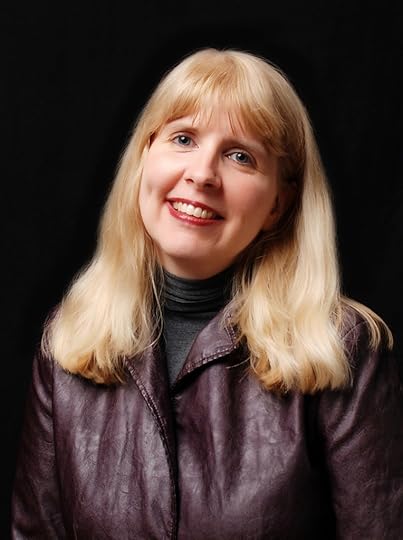
Joanna Schaffhausen is the author of the award-winning Ellery Hathaway series as well as the forthcoming thriller Gone for Good. She has a doctorate in psychology, which reflects her long-standing interest in the brain―how it develops and the many ways it can go wrong. Previously, was an editorial producer for ABC News, writing for programs such as World News Tonight, Good Morning America, and 20/20. She lives in the Boston area with her husband, daughter, and basset hound Winston.
January 20, 2021
Wicked Wednesday: First Love
Wickeds, I was going to ask about the first time you fell in love. Instead, let’s delve into some protagonist back story. Who was the first person your protagonist fell in love with? How did it start, and how did it end? Are they still (or again) in touch? Anybody Go! I will give away a copy of any of the Country Store mysteries except the first one (sorry, out of copies).

Julie: In my Garden Squad series, I love Lilly’s love backstory. Her first husband was Pete Frank. They’d known each other forever, and marrying him felt like the logical step in Lilly’s life. She may have thought she was in love with him, but Lilly is very practical and I don’t think she expected hearts, flowers and fireworks. Pete left her, and she focussed on her career. Then she met Alan. Alan was her first love. When the series starts, she’s just coming out of a period of deep grief over his death. I love how grateful she is to Pete for leaving her, so that she could meet and love Alan. Lilly’s in her mid-sixties now. As I’m working on the 5th book, I don’t think she’s done with love.
Edith/Maddie: I love Lilly’s backstory, too, Julie. Mac Almeida in the Cozy Capers Book Group Mysteries had a big love when she was in college at Harvard. He was affectionate, creative, and nudged her out of her obsession with neatness and order a little. Alas, he died in a skiing accident. After she got over her grief, Mac found the dating scene too messy for a number of years. She can’t quite believe her luck at finding baker Tim, who is pretty much perfect and adores her.
Barb: This question is an easy one with the protagonist in the Maine Clambake Mysteries, Julia Snowden. She’s in a grown-up relationship with Chris Durand, her middle-school crush–the heart-pounding, weak-in-the-knees, tongue-tying kind of crush. But now they’re adults, with adult baggage and adult challenges, and life is a lot more complicated.
Jessie: My sleuths are on opposite ends of this spectrum. Edwina, a proper English spinster and surplus woman is actually a desperate romantic and has never been in love with an actual person. She has had rather a soft spot for many fictional characters however. On the other hand, her dear friend Beryl, has been in and out of love so often she could probably not remember her first love!
Sherry: It’s so interesting to see the different takes everyone has on romance in their books. Sarah was eighteen when she met her husband CJ. Her mom forbid her from dating the men stationed at the Army and Navy bases in Monterey. So Sarah rushed right up to the Presidio near her house and ran (literally) into CJ. I didn’t know how they actually met until I wrote about it in book three All Murders Final. It even surprised me!
Readers: Tell us about your first love, human, furry, or literary! One of you will win a copy of one of my Country Store Mysteries, your choice (except book #1, Flipped for Murder).
January 19, 2021
A Wicked Welcome to S.G. Wong
by Julie, settled in Somerville
I have had the great good fortune to work with S.G. (Sandra) Wong for several months in her role as president of Sisters in Crime. Her passion for the organization, and the writing community, is a force. She’s also a multi-published author, with a fabulous series and exciting news about a stand alone. But I’ll let her tell you her story. I’m so glad that she agreed to visit the Wickeds today. Welcome, Sandra!
The first novel I ever wrote was, in my humble and subjective opinion, a hot mess. It was my first (also last) attempt at the Great Canadian Novel—which bears close resemblance to the Great American Novel, except that ours usually involve a lot of bleak winters and feelings of isolation under endless prairie skies sort of thing.

Actually, I’m not precisely sure I finished it. I recall a shaky beginning, a poor end, and some murky bits in the middle. I could hunt it down to take a peek, but it’s buried in an ancient hard drive, and really, I’d only ever print it out to burn the tortured thing, so let’s just leave it buried.
I was so scared every day writing that first novel, not to mention bewildered, and it turned out to be a terrible disappointment. But not a surprise. Though I’d studied many of those kinds of books during my English Lit degree, my heart was never invested in them.
What did surprise me, after all that fear and unrewarding toil, was the urge to keep writing.
As a first-time mum in 2003, I worked through a stack of Philip Marlowe novels amid feedings, diapers, naps (baby’s, not mine), laundry, and myriad previously unknown anxieties. Apparently, my sneaky brain was shooting its creative synapses in secret while I dragged my exhausted body through the daily routines of new motherhood, because I found myself with an idea in the middle of an overnight feeding: What if the femme fatale were the hard-boiled PI?
I ended up creating an entire fictional world, Crescent City, for my tough-talking glam gal of a PI, Lola Starke, to inhabit. I finished writing my first crime novel in 2006. Un-agented, I signed with a modest imprint in 2012. Between 2013-16, I published 3 books in that series. I currently have numerous short stories published in anthologies. I have a few awards nominations.
But I also feared I didn’t have it in me to write novels about anyone other than Lola or anything other than Crescent City. (Oh Impostor Syndrome, you devil, you.)
In 2018, my brain zigged when I thought I was zagging. This time, a dark idea while on a romantic getaway. (Lemme just say: my husband really understands me and my macabre, sneaky brain.) I was equal parts intrigued and terrified by this story idea. I’d never tried anything remotely like it.
But the urge to write this story was so overwhelming, it obliterated my fears of failure. (Also, what would be the worst possible result? A terrible book? I already wrote one of those and I’d survived.)
So in 2019, I finished writing my first contemporary domestic suspense novel. I signed with an agent. I secured a new book contract. (Whew. Those three sentences skip over a lot of hard work and minor dramas.) Soon, I’ll get to work with a veteran editor at HarperCollins Canada. Summer 2022, I get to see my first “mainstream” book released into the wild.
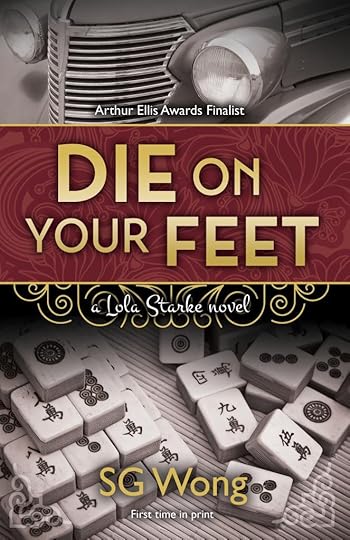
First times can be challenging, frightening, thrilling—all at the same time. We won’t always feel lucky or even grateful for them in the moment, and they often require some combination of blood, sweat, and tears, but if we stay curious and open, one new thing can lead to the next and the next and the next after that, creating a wonderful daisy chain of possibilities and experiences. I like to think that’s how we design a full life for ourselves: one step at a time, toward the next new challenge.
What’s a first for you, something you’ve not tried before, that feels equal parts scary and exhilarating? (Bonus points: Are you willing to try it anyway?) Comment to enter a draw to win one signed print copy of DIE ON YOUR FEET, the first Lola Starke novel. (Open to Canada and the U.S.)
Thank you so much, Julie and the rest of the fabulous Wicked Authors, for hosting me today!
Bio: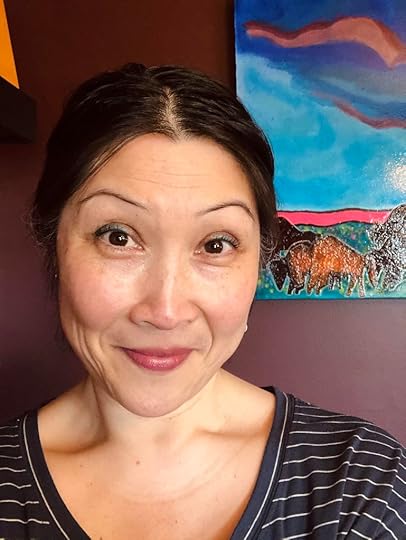
Sandra S.G. Wong writes fiction across genres, speaks on writing and publishing topics, and volunteers for important community causes. She has been a finalist in the Arthur Ellis Awards for Excellence in Canadian Crime Writing (Best First Novel and Best Short Story) and longlisted for the Whistler Independent Book Awards (Best Crime Fiction). sgwong.com
About the Lola Starke novels:The Lola Starke series is set in 1930s-era Crescent City, a fictionalized “Chinese Los Angeles” in an alternate history in which China established a city-state colony at the start of the Gold Rush. This alternate history also contains ghosts and magic, historically-accurate fashion, and plenty of attitude.
January 18, 2021
Cover Reveal!
Jessie: In New Hampshire where the snow was melted away by Saturday’s heavy rains.
Covers! Ah covers! They are one of the trickiest parts of the publishing business. They have to convey in images and a few choice words why in the world anyone would be interested inthe contents contained behind them. A cover must provide a sort of shorthand of the tone, genre and emotinal ride a book will provide whilst simultaneously making room for the title, the recommendation of others and all the stock-keeping information like bar codes and price. I am always in awe of the task set before them!
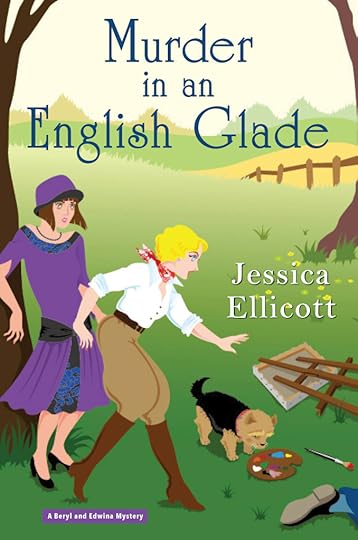
I have been lucky enough to have a single cover designer for each of my Beryl and Edwina books thus far. I am even luckier to be able to contribute to the conversation about what the covers should include months before they are created. I share images on Pinterest boards as well as lists of keywords and short phrases pointing out important bits of information like the time of year, the method of murder, the general setting.
After that the wizards in the Art Department take over and start drafting something that manages to include what they think is relevant and also appealing to the majority of lighthearted historical mystery readers. After long enough for me to have forgotten there is a cover in the works somewhere I receive an email from my editor with the image of it attached.
I think this one turned out quit charmingly. In fact, I think it may be my favorite for the series thus far! It reminds me of a vintage Nancy Drew Mystery cover. I am delighted with the way it points to what is transpiring in the mystery without giving too much away. Beryl and Edwina look rather dashing, just as a pair of intrepid sleuths should!
Readers, does this cover make you think of vintage Nancy Drews? Writers, do you have a favorite cover for one of your books?
January 16, 2021
Tramp Art and a Giveaway
In Absence of Alice, Sarah Winston is doing a sale for a client who has a collection of tramp art. I first learned about tramp art when we unearthed a piece in my grandparent’s basement on their farm in Novinger, Missouri. My mom uses it to display shells in her house.

Tramp art is a bit of a misnomer. Here is a bit about it from Old House online: Tramp art is the whimsical name given to a folk-art form that was popular ca. 1870 to 1940. Boxes, picture frames, religious artifacts, and decorative objects were chip-carved from cigar boxes and, less often, from packing crates. The wood was notch-carved with squares, triangles, and rectangles, then layered to created three-dimensional, boldly geometric pieces. Some are inlaid with carved hearts, leaves, or stars; others feature applied decoration made of “found” materials like bits of china or mirrored glass. Larger pieces can run to mantel clocks and tables with drawers.
I think mom’s piece is made out of an old crate.


If you look closely on the right side it says Novinger MO!
I did a lot of research about tramp art which led me to eBay which led me to a purchase. Imagine that — the sacrifices I make for my art. I bought three frames that were grouped together. They are all about 12 1/4 by 10 1/2. Here is one of them:
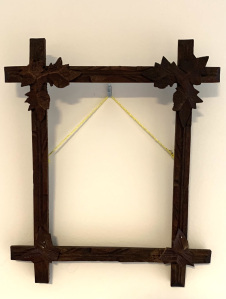
Here is a close up of the detail:


Monday I taped an episode of Antiques Roadshow and what do you know there was a piece of tramp art! Here’s a close up of some of the detail.

If you are interested in seeing more about the piece you can watch here: https://www.pbs.org/wgbh/roadshow/season/12/baltimore-md/appraisals/pennsylvania-tramp-art-dresser-ca-1910–200701A35/
I decided I didn’t need to keep three tramp art frames so I’m giving away the one pictured above on my author Facebook page. Leave a comment there for a chance to win: https://www.facebook.com/SherryHarrisauthor
I’ll give away a copy of Absence of Alice here!
Readers: Have you heard of tramp art before? Do you have a piece?

